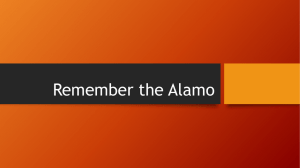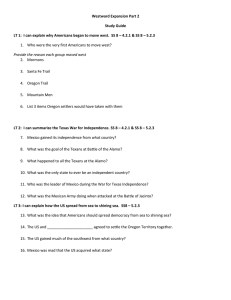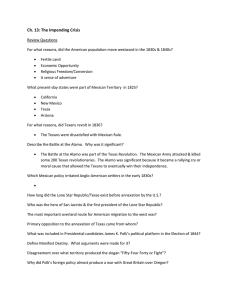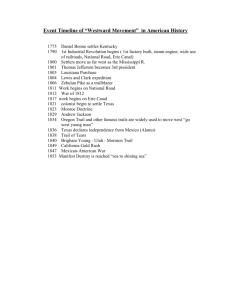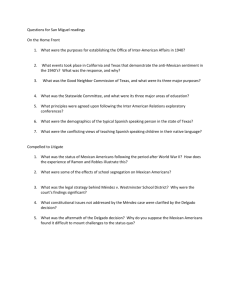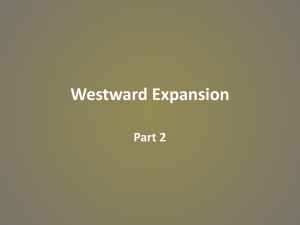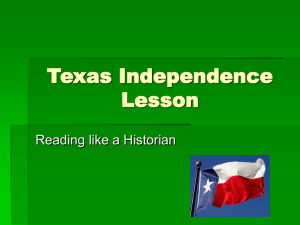File - Harper Parkey
advertisement
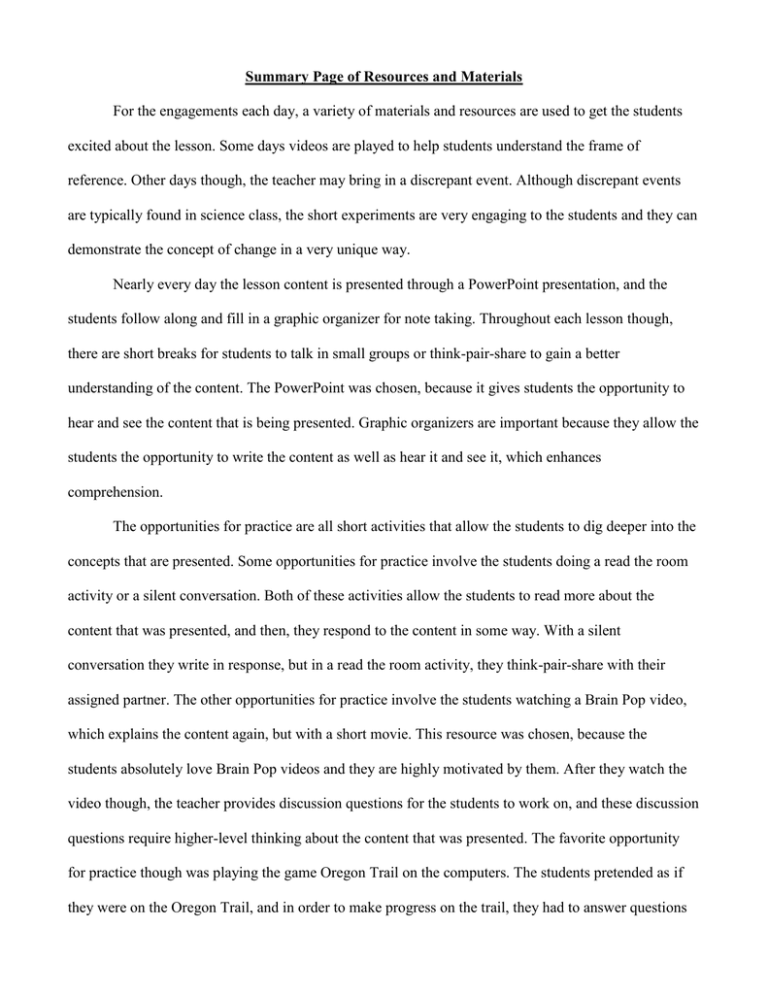
Summary Page of Resources and Materials For the engagements each day, a variety of materials and resources are used to get the students excited about the lesson. Some days videos are played to help students understand the frame of reference. Other days though, the teacher may bring in a discrepant event. Although discrepant events are typically found in science class, the short experiments are very engaging to the students and they can demonstrate the concept of change in a very unique way. Nearly every day the lesson content is presented through a PowerPoint presentation, and the students follow along and fill in a graphic organizer for note taking. Throughout each lesson though, there are short breaks for students to talk in small groups or think-pair-share to gain a better understanding of the content. The PowerPoint was chosen, because it gives students the opportunity to hear and see the content that is being presented. Graphic organizers are important because they allow the students the opportunity to write the content as well as hear it and see it, which enhances comprehension. The opportunities for practice are all short activities that allow the students to dig deeper into the concepts that are presented. Some opportunities for practice involve the students doing a read the room activity or a silent conversation. Both of these activities allow the students to read more about the content that was presented, and then, they respond to the content in some way. With a silent conversation they write in response, but in a read the room activity, they think-pair-share with their assigned partner. The other opportunities for practice involve the students watching a Brain Pop video, which explains the content again, but with a short movie. This resource was chosen, because the students absolutely love Brain Pop videos and they are highly motivated by them. After they watch the video though, the teacher provides discussion questions for the students to work on, and these discussion questions require higher-level thinking about the content that was presented. The favorite opportunity for practice though was playing the game Oregon Trail on the computers. The students pretended as if they were on the Oregon Trail, and in order to make progress on the trail, they had to answer questions correctly. The students absolutely loved this opportunity to practice, and I have even seen several students playing the game in free time after school. The assessments have the most variety of resources used throughout this unit. Some assessments are simple like journal prompts or exit slips. However, the students’ favorite assessments required the use of technology. These assessments were Socrative, Kahoot, and Plickers. They are all technologybased assessments that give detailed feedback to the teacher about student responses. Not only are these assessments beneficial for the teacher, but they are also highly motivating to the students as well. Technology is heavily incorporated into this unit, because it enhances the lessons and most technology is highly motivating to my particular class. A detailed analysis of all technology incorporated can be found in the technology tab of this unit. Music and Art are incorporated in small quantities in this unit, through songs or small drawings and paintings. They are not the focal point of the unit, but they are available as options. However, a full lesson for music and art can be found in the cross-curricular section of this unit. Throughout the unit a variety of materials and resources are used to enhance instruction, make it engaging, and differentiate to appeal to a variety of learning styles. While there is plenty of direct instruction, the materials provide visuals for students and allow the students to dig deeper into the lesson content. A list of all materials and resources needed to complete a lesson are listed at the end of each lesson plan. Materials and Resources Chart Lesson Introductory Activity Concept of Change Materials and Resources Whole milk Food coloring Q-Tip Dawn dish soap Chart paper (6 sets) Six different colors of markers (4 of each color) Student computers “chrome books” Day One The Corrupt Bargain PowerPoint Projector Handouts for each student Pencils for each student Video https://www.youtube.com/watch?v=lXs9Li8bB64 Internet access to play the video Plickers cards Plickers assessment Day Two Andrew Jackson’s Presidency PowerPoint Graphic Organizer Brain Pop Student pencils Post It Notes or scraps of paper Internet Access Projector Day Three Indian Removal Act and the Trail of Tears PowerPoint Personal story from Trail of Tears Projector Kahoot Teacher computer to play the Kahoot Student computers to access the Kahoot Day Four Mexican-American War PowerPoint Mexican American War Graphic Organizer Discussion questions (on PowerPoint) Projector Brain Pop Video Exit slips Student pencils Day Five Oregon Trail and The California Gold Rush PowerPoint Schoolhouse Rock video Culminating Lesson Webquest for Review https://www.youtube.com/watch?v=FfoQBTPY7gk Projector Computer Student pencils Student computers Link to Oregon Trail Game https://archive.org/details/msdos_Oregon_Trail_The_1990 Socrative Assessment YouTube video for engagement https://www.youtube.com/watch?v=wRSIFmlJwgM Student computers “chrome books” Graphic organizer for responses to the webquest questions Student pencils Projector Teacher computer Name Date # Andrew Jackson Tariff Debate Bank of the United States Old Hickory Native American Removal Policy Gold Rush! Structured Notes Follow along to gather the definitions for the following vocabulary words: i. Treaty of Guadalupe Hidalgo __________________________________________________________________________ ii. James W. Marshall _________________________________________________________________________________ iii. Coloma, CA __________________________________________________________________________________ iv. Gold Rush __________________________________________________________________________________ v. Forty-niners __________________________________________________________________________________ vi. Placer Mining __________________________________________________________________________________ vii. Hard Rock Mining __________________________________________________________________________________ viii. Boomtowns __________________________________________________________________________________ ix. Oregon Trail __________________________________________________________________________________ x. California Trail __________________________________________________________________________________ xi. Steamships _________________________________________________________________________________ xii. Angel Island ________________________________________________________________________________ xiii. Transcontinental Railroad __________________________________________________________________________ xiv. 1882 Chinese Exclusion Act _________________________________________________________________________ xv. Klondike (Alaska) Gold Rush ________________________________________________________________________ Gold Rush! 1) Write a sentence about the Gold Rush using all of the following terms: Oregon Trail, California Trail, Gold Rush, Donner Party ______________________________________________________________________________ _______ ______________________________________________________________________________ _______ 2) In your own words, what is the difference between ‘placer mining’ and ‘hard rock mining’? ______________________________________________________________________________ _______ ______________________________________________________________________________ _______ 3) What does the Chinese Exclusion Act have to do with the Gold Rush? ______________________________________________________________________________ _______ ______________________________________________________________________________ _______ 4) Fill in some positive effects and some negative effects from the California Gold Rush… 5) Use the Venn Diagram to compare and contrast the California Gold Rush and the Klondike Gold Rush… Texas Revolution Cloze Reading WORD BANK Some words will be used twice. Polk Velasco Hickory 1,544 Alamo Slavery Independenc Destiny U.S. Tyler e San Jacinto Houston Army 189 Revolution Southerner San Antonio Mexico Republic s Sam Houston Anna Rio Grande Sectional Northerners 13 Annexation Rebellions broke out in Texas. This became known as the Texas __________________. Mexican president at the time was General Santa __________. He was determined to force the Texans to obey Mexican laws. So he sent an army to ___________________, Texas. The Texans moved into an old Spanish mission called the ____________. They hoped to hold off the Mexican army and prevent them from moving any farther north into Texas. The Mexican army attacked the Texans holed up in the Alamo. o Fight lasted from late February until March 1836—about ________ days. o While the fight was going on, Texas declared its ____________________ from Mexico and drew up a constitution like the United State’s one. o Finally, in early March, the Mexican army broke into the Alamo, and all ______ Americans were killed. However, in the process, the Mexican army suffered ________ deaths to take the Alamo! The fight at the Alamo inspired many Texans. 6 weeks after the defeat there, the Texans fought the Mexican army near the ________________ River. o Led by General Sam ______________, crying “Remember the _____________,” they defeated the Mexicans, killing 630 of them in _____ minutes. They also captured Santa Anna, held him at gunpoint, and forced him to sign a treaty (Treaty of __________) recognizing Texan ______________________ and the _________________ River as the southern border. Mexican government didn’t recognize the treaty. o So Texas became an independent country in 1836—________________ of Texas And Texans elected ____________________ president. Would Texas join the _______? Most Texans wanted to. However, since Texas had ________, Americans were divided over annexation. Many ____________________ wanted to annex Texas to expand slavery. Many ____________________ were against annexation because they didn’t want there to be more slave states than free ones. Northerners also feared that if the U.S. annexed Texas, it might cause a war with __________________. Eventually, Texas was annexed, in December 1845. Voting in Congress was ________________. Annexation happened due in large part to President James K. ___________, who was the President after John Tyler. He was elected in 1844 largely because he supported the ________________ of TX. He was nicknamed “Young _____________.” He loved the idea of manifest ________________. He was a slaveholder (who strongly favored annexation of Texas to spread slavery). Answer Key Rebellions broke out in Texas. This became known as the Texas Revolution Mexican president at the time was General Santa Anna o He was determined to force the Texans to obey Mexican laws. So he sent an army to San Antonio, Texas. The Texans moved into an old Spanish mission called the Alamo. They hoped to hold off the Mexican army and prevent them from moving any farther north into Texas. The Mexican army attacked the Texans holed up in the Alamo. o Fight lasted from late February until March 1836—about 13 days. o While the fight was going on, Texas declared its independence from Mexico and drew up a constitution like the United State’s one. o Finally, in early March, the Mexican army broke into the Alamo, and all 189 Americans were killed. However, in the process, the Mexican army suffered 1,544 deaths to take the Alamo! The fight at the Alamo inspired many Texans. 6 weeks after the defeat there, the Texans fought the Mexican army near the San Jacinto River. o Led by General Sam Houston, crying “Remember the Alamo,” they defeated the Mexican army, killing 630 of them in 18 minutes. They also captured Santa Anna, held him at gunpoint, and forced him to sign a treaty (Treaty of Velasco) recognizing Texan independence and the Rio Grande River as the southern border. The Mexican government didn’t recognize the treaty. o So Texas became an independent country in 1836—Republic of Texas And Texans elected Sam Houston as president. Would Texas join the U.S. ? Most Texans wanted to. However, since Texas had Slavery, Americans were divided over annexation. Many Southerners wanted to annex Texas to expand slavery. Many Northerners were against annexation because they didn’t want there to be more slave states than free ones. Northerners also feared that if the U.S. annexed Texas, it might cause a war with Mexico. Eventually, Texas was annexed by the United States, in December 1845. Voting in Congress was Sectional. Annexation happened due in large part to President James K. Polk, who was the President after John Tyler. He was elected in 1844 largely because he supported the annexation of TX. He was nicknamed “Young Hickory.” He loved the idea of manifest destiny. He was a slaveholder (who strongly favored annexation of Texas to spread slavery). Political Cartoon Analysis Andrew Jackson List the objects you see in the cartoon. List significant words or phrases. List adjectives that describe the emotions of the cartoon. Describe any symbolism you see in the cartoon. What do you think the artist’s opinion is of Jackson? Based on the artist’s caricature, what kind of president do you think Andrew Jackson was? Explain your opinion, citing evidence from the cartoon. (30 word minimum) Traveling West # 1 What was the Oregon Territory? Why did people want to travel to Oregon? Describe what a covered wagon would look like? What was a wagon train? Who lead the wagon train? What is a trail guide? What are some things that made him a good trail guide? Name________________________

